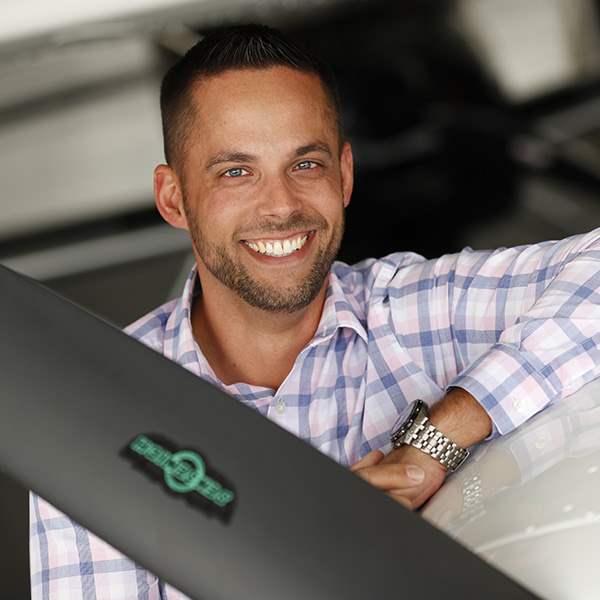Flying the AOPA Sweepstakes Cessna 170 to AirVenture
Another first, and another trip out of the comfort zone for AOPA social media marketer
Once again tasked with flying an aircraft to do things outside of my comfort zone, I got a quick checkout in the AOPA Sweepstakes Cessna 170B and then flew it to EAA AirVenture Oshkosh 2022 the next day.
After getting checked out in the AOPA Sweepstakes Cessna 170, I flew it to EAA AirVenture Oshkosh 2022 in Wisconsin from the Atlanta area by way of Tullahoma, Tennessee, and Danville and DeKalb, Illinois. No phones were lost during this adventure.
Almost all my tailwheel experience has been in Piper PA–18 Super Cubs. I’ve flown a Cessna 140 and found the spring gear much less forgiving than that of the Super Cub, so I’ll admit I was a little intimidated at first.
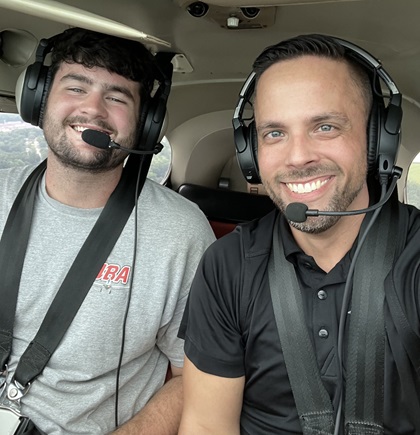
After flying from Maryland to Atlanta in a Boeing 737-700, I hopped in the AOPA Sweepstakes Cessna 170 with Parker Thaxton, a 23-year-old with several hundred hours’ experience in Cessna 170s, and he walked me through the characteristics of flying this beautiful aircraft. Anticipation is key for any tailwheel airplane, especially so for the Cessna 170. He explained all the nuances and tendencies, and especially cautioned me about crosswinds until I’m more familiar with the airplane.
Feeling less uncomfortable about flying this airplane all the way to AirVenture, I set off from the Atlanta area (after waiting out some morning IFR conditions) and headed for Tullahoma, Tennessee. The airport is on the way, and I have a lot of good friends there I haven’t seen for a while. Ninety minutes later, I was bouncing my way onto the grass runway at Tullahoma Regional/Wm Northern Field. I say “bounced” because I flared a little too high and dropped it in. Of course, all my friends had decided to come to the airport that day and watch my less-than-stellar landing. Thankfully they were far enough away that they didn’t get a good look.
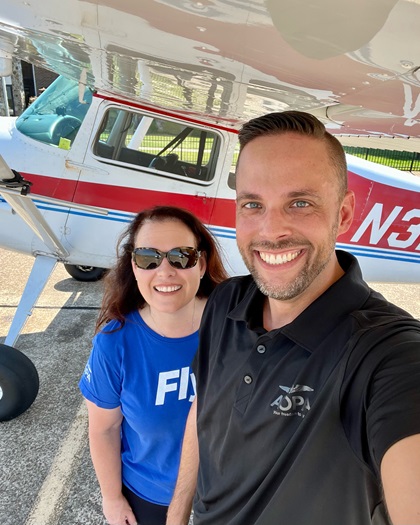
AOPA High School Aviation Initiative Manager Karla Smith was there with her parents Charles and Nellie Maddle, who have honorarily adopted me as their son. Charles Parish, executive vice president of the Beechcraft Heritage Museum, was also in attendance. If you haven’t had a chance to stop by the museum, you really need to. Some of the aircraft in the museum you won’t see anywhere else. (Beech Party 2022 would be a great opportunity if you have some time to spare October 13 through 15.) Airport Manager Jon Glass, who was sitting in his utility vehicle on an adjoining taxiway, was first to greet me with his customary wave.
The Cessna 170 was quickly swarmed by some of the local pilots. They commented on how nice the interior looks (it’s really incredible how good it looks) and, of course, some friendly, good-natured ribbing about my less-than-perfect landing. Parish was quick to rush to my defense about the Cessna 170 being more than a handful at times and said for only my sixth landing and with only two hours in the airplane, I should be pleased with my progress. Who am I to argue?
While I was there, I met Tommy Johnson, an instructor at Sewanee: The University of the South. He was soloing a student in the Sewanee Flying Tigers’ factory-new, G-1000-equipped Cessna 172. I took some photos and videos during the shirttail cutting and shared with them.
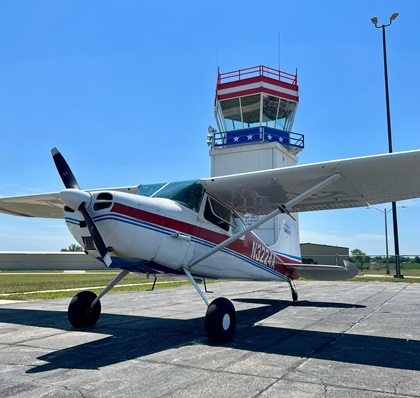
With the Cessna 170 laden with full fuel tanks, four quarts of oil, some of Mrs. Maddle’s sweet tea, a dozen donuts, and ten Chick-n-Minis from Chick-fil-A, I set off for Vermilion Regional Airport in Danville, Illinois. At the airport, I came across a Beechcraft group of no less than 15 airplanes, all headed to AirVenture. I had other things to occupy my mind, though. While the Cessna 170 had been performing beautifully, the oil temperature gauge had been pegged near the top of the green arc. It had been the same during my checkout flight and for the flight to Tullahoma, but because it had just had an oil change, we all thought the oil dripping from under the cowl was blowing out from being overfilled. I had over five quarts showing on the dipstick at Tullahoma. At Danville, I refueled the airplane, used the restroom, and checked the oil to find it showing over three quarts on the dipstick. I poured two quarts of oil into the engine, verified the reading on the dipstick, and nervously set off again. (I later learned that the engine in our Cessna 170B can consume nearly 1.25 quarts of oil per flight hour and be within factory tolerance).
AOPA Social Media Marketer Cayla McLeod Hunt, who was planning to set off later that day with her husband, Ryan Hunt, was keeping an eye on things at Oshkosh and sent me a text suggesting I make another fuel stop between Danville and Wittman Regional Airport in case I needed to hold before heading in to the show. One of my planned navigation waypoints was DeKalb Taylor Municipal Airport in Illinois, so I landed and topped off the fuel. I met another pilot named Michael, also headed to AirVenture, who recognized the Cessna 170. He said it was pretty anticlimactic for me to deliver the airplane to him so soon after the sweepstakes aircraft’s unveiling, but he’d be more than happy to take possession of it.
He also happened to notice the oil dripping onto the ramp and asked if I had a radial engine under the cowl. I explained my experience at the previous stop and that the airplane had a tendency to leak oil, but that all the gauges had shown consistent temps and pressures, and that I’d stayed on top of keeping it topped off. Once again, I topped off the tanks, took care of my restroom needs, and checked the oil again—this time showing five quarts. Not bad to burn off a half-quart in an hour.

The last leg, from DeKalb to Oshkosh, made me the most nervous. The AOPA Sweepstakes Cessna 170 is not yet equipped with ADS-B Out. The extent of its functional navigational equipment is a compass and a really solid heading indicator. I had my iPad (on the seat beside me in the shade), and the incredible ForeFlight Sentry Plus on the window. Without that, I would’ve had a much more difficult (and mentally exhausting) time of navigating to AirVenture. Thanks to our friends at Sporty’s for allowing us to borrow it and run it through its paces.
I was worried about other pilots flying to AirVenture not being able to see me on their traffic displays. I could see them, thanks to the Sentry Plus, but they’d have to spot me with their eyes. I tuned in the Oshkosh ATIS 60 miles out but heard nothing. I tuned the Fisk Arrival frequency and heard air traffic control asking pilots to rock their wings, so I knew there was nothing wrong with the radio. I reluctantly climbed (slowly) from 2,000 feet msl to 4,000 feet msl before I was able to pick up the frequency. I got information Hotel, then returned to 3,000 feet msl for a proper VFR altitude for my slightly northwesterly heading.
Further mild panic ensued when I heard the ATIS report that Runways 27 and 18R were in use with winds 210 at 9 knots gusting to 17 knots. Thaxton had told me to be wary of crosswinds, and even advised me not to fly in winds greater than 10 knots until I was more familiar with the airplane. I had about 5 knots of crosswind at Danville and had one of my better landings so far.
The actual Fisk Arrival and transition weren’t nearly as difficult as I had imagined. The visual points of reference contained in the Oshkosh Notice were easy to spot, and ATC provided general reminders about spacing, staying over the railroad tracks, and maintaining 90 knots at 1,800 feet. It was my turn. “We got a high-wing, half-mile southwest of Fisk: rock your wings.” That’s me! “Good rock for the high-wing taildragger! Do you have a runway preference?” Yup, I sure did. I’d rather have a 30-degree quartering headwind than a 50-degree, so I asked for runway 18R. “Absolutely. Taildragger over Fisk, turn right and join Fisk Avenue. That’s the east-west road. You’re going to enter a left downwind Runway 18. Good turn. Monitor tower 126.6. Enjoy the show.”
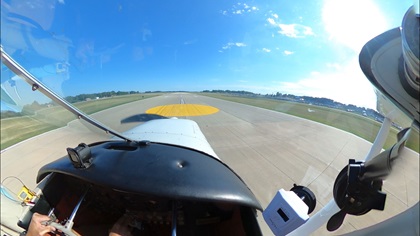
I swapped over and continued flying down Fisk Avenue, looking for my base turn. As I was starting my turn, the tower controller chimed in, “High-wing taildragger, turn your downwind, start your descent. High-wing taildragger keep that descent coming down. It’s gonna be a tight left base, not a whole lot of room to work with. Keep that descent coming down.” I knew from the Oshkosh Notice that I’d turn my base at the pink dot. But once again, the tower controller chimed in, “High-wing taildragger, turn your base.” Followed with, “High-wing taildragger keep that left turn coming all the way around. I want you to aim towards the pink dot. You’re cleared to land at or after the yellow dot.” With 40 degrees of flaps, that was easy enough to do. The tower controller called again, “High-wing taildragger, keep that left turn coming all the way around. At or after the yellow dot for me.”
I landed just after the yellow dot and was off at the next taxiway (about 325 feet according to a Google Maps image). For most, I’m sure that’s not a big deal, but for only my tenth landing and for having been introduced to it the day before, that says a lot about the aircraft’s abilities.
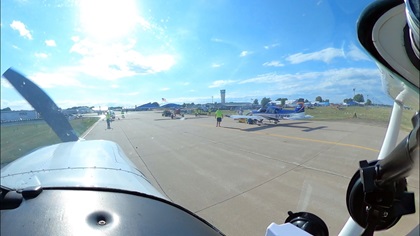
I followed the marshallers and was directed to Boeing Plaza and found AOPA Senior Vice President of Media and Marketing Kollin Stagnito and his son, Tony, standing beside the AOPA Sweepstakes Grumman Tiger. They had flown it in from the Chicago area. It took a minor feat of logistical effort to bring these two aircraft together at nearly the same moment having from two different parts of the country and having very different cruising speeds.
What is it about the Cessna 170 that makes it so iconic? I noticed right away that banking felt a lot like the Cessna 172s I trained in. The elevator is very effective, which could have the potential to get someone in trouble if they aren’t prepared. The big, arcing rudder is more than sufficient in the air. The interior felt a lot like a Cessna 172. Because of the seat placement, I couldn’t sit with my shoulders squared, so that had my left arm feeling stiff by the time I parked at Oshkosh. Headroom is more than sufficient; I didn’t hit my head on the headliner in turbulence like I did in the Grumman Tiger on my way to the Sun ‘n Fun Aerospace Expo earlier this year. The spring steel gear and tundra tires can handily absorb a high flare. The tradeoff is the tendency to bounce if you aren’t smooth at touchdown, which can be rectified with a go-around.
Although it lacks power and a lot of modern instrumentation, and leaks oil like a radial engine, it’s easy to see why people love the Cessna 170 so much. I’ll miss the Grumman Tiger’s nimble handling and fast cruise speed, but this Cessna 170 sure is a lot of fun. Whoever wins this airplane is going to fly the wings off it.
If you’re at EAA AirVenture Oshkosh 2022, stop by our campus. We’re at Booth 463, right across from the iconic Brown Arch. You can get one last look at the 2022 AOPA Sweepstakes Grumman Tiger before its new owner, Alex Browne, flies home to California, and get your first look at the 2023 AOPA Sweepstakes Cessna 170.
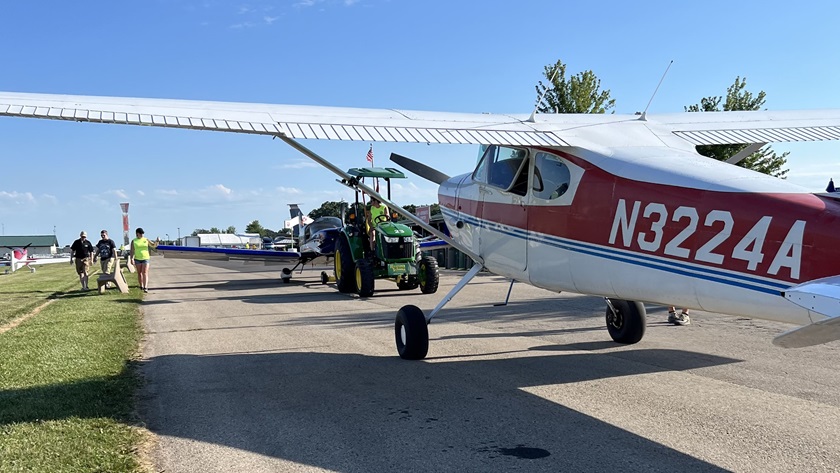
Claim your chance to win this airplane today.
No purchase or contribution necessary to enter or win. A purchase or contribution will not improve your chances of winning. Open to 50 U.S. states and the District of Columbia, Canada (excluding Quebec), Guam, Puerto Rico and the U.S. Virgin Islands, age 19 years or older (or at least the age of majority as legally mandated by the entrant’s jurisdiction of residence if greater than 19) at date of entry. Ends at 11:59 p.m. Eastern time on December 29, 2023. To enter and view complete Official Rules which govern this Sweepstakes, including, entry limits, and alternate method of entry, visit https://www.aopa.org/sweeps. Sponsored by the Aircraft Owners and Pilots Association.
